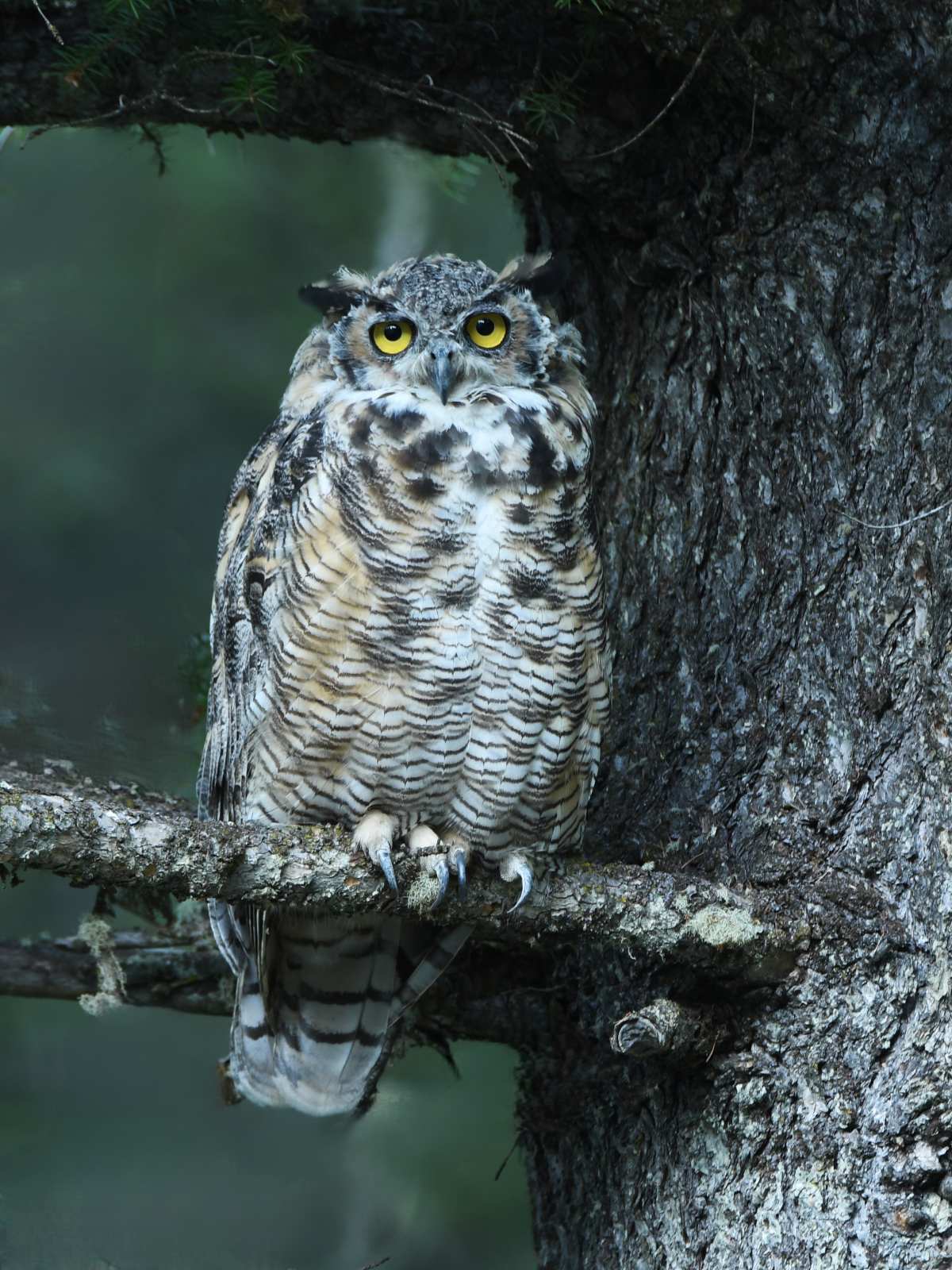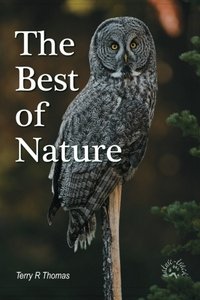Life After Dark

While not all owls are nocturnal, Great-horned owls are, hunting at night and resting during the day.
The video posted on social media showed a large grizzly sow and two cubs hopefully inspecting trashcans at a residence in Island Park. During the daylight hours, you would never suspect that the grizzly family was there as this was in the middle of a neighborhood, not at some remote cabin far off the beaten path. The crazy thing is that this is not an uncommon occurrence. Grizzly bears and black bears, even occasionally wolves and mountain lions, are routinely captured wandering our streets and backyards at night.
Animals that utilize the cover of darkness (night) to go about their business are said to be nocturnal. This can be facultative or obligatory, big words that mean that the animal chooses to be active at night or is adapted to a nocturnal lifestyle that requires it to be active at night.
Sometimes, animals choose the nighttime because certain activities either demand it or enhance their abilities. For instance, many daytime active birds migrate at night, likely for several reasons. One, some birds navigate using the stars and stars and moon which are only visible at night. At night, thermals, those convective rising columns of heat, subside, making direct flight easier. Migrating at night they are less susceptible to predators and migrating at night allows them to feed during the day.
In the dance called evolution, smaller prey species learned that the night is a safer time to go about their business. However, their dance partners, the predators, have adapted to nocturnal prey strategies and hunt at night as well, matching prey adaptation with their own. Each morning in the winter, I find fresh fox tracks in my driveway snow. If I put a camera out, I will often be rewarded with a nighttime fox photo. That predators hunt at night is evidenced by the fact that most roadkills happen after dark. While predators like foxes, coyotes, skunks, badgers, and pine marten also hunt during the day, they have adapted to spend time hunting at night, making them facultatively nocturnal.
There are other animals though that are strictly nocturnal (obligate) and have adapted specific features to enhance life in the dark. Flying squirrels have extra-large eyes packed with rods (eye structures that aid in seeing at night) and sensitive whiskers that enhance their abilities to see and feel at night. About 70 percent of bats have developed echo-location for navigation and hunting. Some owls (not all) like the great-horned owl, barn owl, and barred owl are fully nocturnal, rarely hunting during the day. While all owls share huge eyes and amazing hearing, they have partitioned the habitat not by area, but by the clock. Some hunt during the day, others during the early morning and late evening, and others at night avoiding competition and taking advantage of different prey species.
Resource partitioning, what the owls are doing, is a good strategy for other animals as well. When livestock are fed, there is a specific time when the food is delivered and managers are careful to see that each animal has a place to eat its share. Just imagine the same scenario in the wild. It is 4 p.m. and every animal that wants a share of a particular food source, say a berry bush, comes to feed. There would be far more squabbling than eating and not everyone would get satisfied. So, some say, “let’s bag this and come back at night when it is less crowded.” They do and it works—they get fed without having to fight for the food. They become nocturnal to reduce competition for resources and over time may adapt special abilities to better live a nocturnal life.
There are other reasons to be nocturnal. We’ll discuss those next time.

Help Idaho Wildlife
When we traveled across the state in October 2017, we visited most of the Idaho Department of Fish and Game wildlife management areas. Most of the vehicles we saw using the wildlife management areas did not have wildlife plates. Buying wildlife plates is a great way for non-hunters and hunters alike to support wildlife-based recreation like birding.
C'mon folks, let's help Idaho's wildlife by proudly buying and displaying a wildlife license plate on each of our vehicles!
See below for information on Idaho plates. Most states have wildlife plates so if you live outside Idaho, check with your state's wildlife department or vehicle licensing division for availability of state wildlife plates where you live.
And tell them that you heard about it from Nature-track.com!
Wildlife License Plates
Great news! as of 2024, there are three NEW designs for license plates. They still are bluebird, cutthroat trout and elk, but they are beautiful.
Idaho Wildlife license plates provide essential funding that benefits the great diversity of native plants and wildlife that are not hunted, fished or trapped—over 10,000 species or 98% of Idaho’s species diversity. Game species that share the same habitats (such as elk, deer, antelope, sage-grouse, salmon, trout) also benefit from these specialty plates.
No state tax dollars are provided for wildlife diversity, conservation education and recreation programs. Neither are any revenues from the sale of hunting or fishing licenses spent on nongame species. Instead, these species depend on direct donations, federal grants, fundraising initiatives—and the Idaho Wildlife license plates.
Both my vehicles have Bluebird Plates. I prefer the bluebird because the nongame program gets 70 percent of the money from bluebird plates, but only 60 percent of the money from elk and trout plates - 10 percent of the money from elk plates supports wildlife disease monitoring and testing programs (to benefit the livestock industry) and 10 percent from cutthroat plates supports non-motorized boat access.
Incidentally, in 2014, the Idaho Legislature denied the Department of Fish and Game the ability to add new plates or even to change the name of the elk and cutthroat plates (very specific) to wildlife and fish plates, a move that would have allowed for changing images occasionally and generating more revenue. It would seem that they believe that we Idahoans don't want a well funded wildlife program.
I think it is time we let the Legislature know that Idahoan support wildlife funding and that we would like to see these generic plates come to fruition.

"WOW. What a phenomenal piece you wrote. You are amazing." Jennifer Jackson
That is embarrassing, but actually a fairly typical response to my nature essays. Since The Best of Nature is created from the very best of 16 years of these nature essays published weekly in the Idaho Falls Post Register (online readership 70,000), it is a fine read. It covers a wide variety of topics including humorous glimpses of nature, philosophy, natural history, and conservation. Readers praise the style, breadth of subject matter and my ability to communicate complex and emotional topics in a relaxed and understandable manner.
Everyone can find something to love in this book. From teenagers to octogenarians, from the coffee shop to the school room, these nature essays are widely read and enjoyed.
Some of the essays here are my personal favorites, others seemed to strike a chord with readers. Most have an important message or lesson that will resonate with you. They are written with a goal to simultaneously entertain and educate about the wonderful workings of nature. Some will make you laugh out loud and others will bring a tear to the eye and warm your heart.
Readers Write:
"You hit a home run with your article on, Big Questions in Nature. It should be required reading for everyone who has lost touch with nature...great job!" Joe Chapman
"We enjoyed your column, Bloom Where Planted. Some of the best writing yet. The Post Register is fortunate to have your weekly columns." Lou Griffin.
To read more and to order a copy, click here or get the Kindle version
Copies are also available at:
Post Register
Island Park Builders Supply (upstairs)
Barnes and Noble in Idaho Falls
Harriman State Park, Island Park
Museum of Idaho
Valley Books, Jackson Wyoming
Avocet Corner Bookstore, Bear River National Wildlife Refuge, Brigham City, Utah
Craters of the Moon National Monument Bookstore, Arco, Idaho